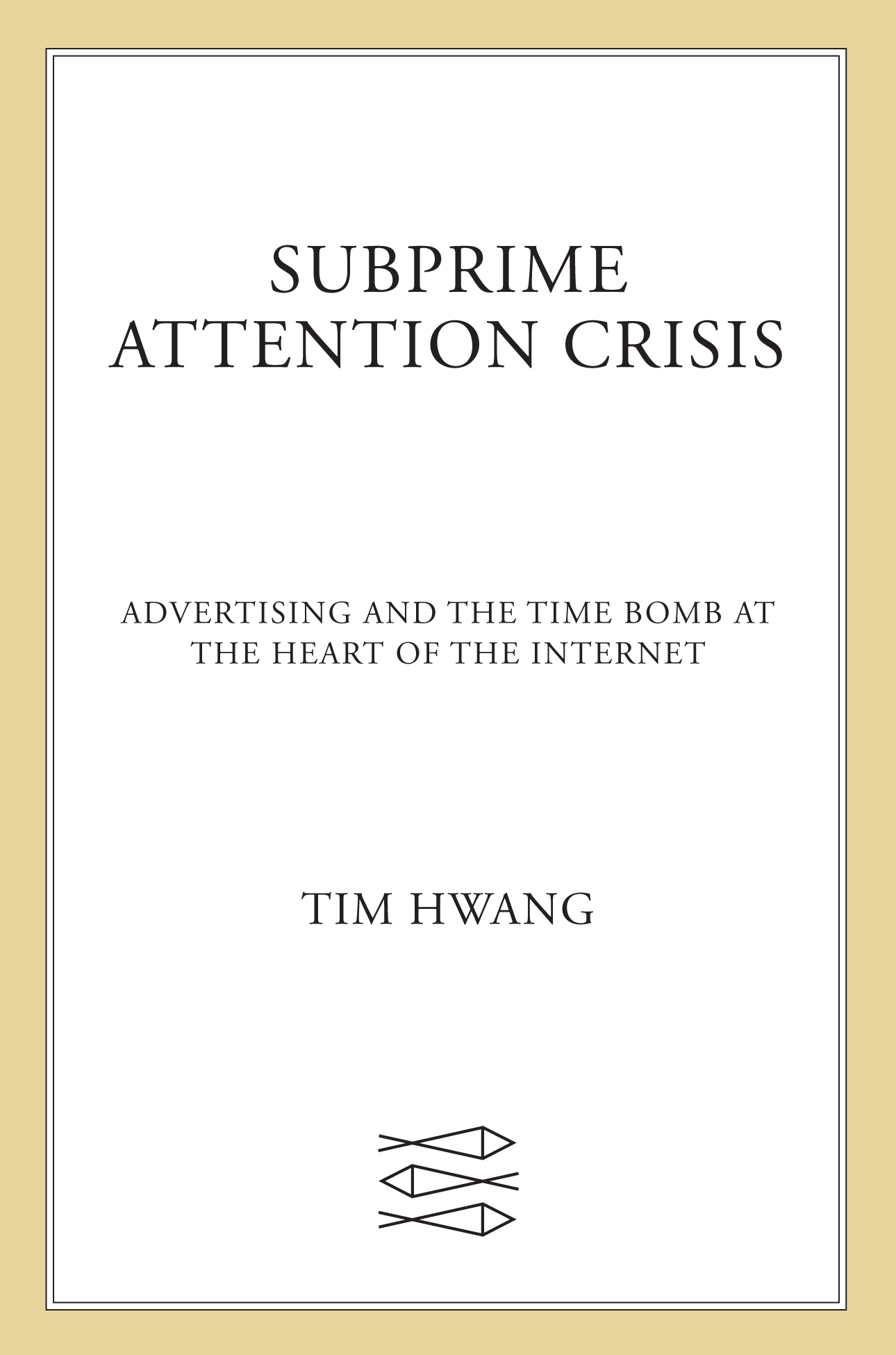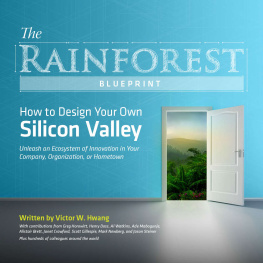Tim Hwang - Subprime Attention Crisis
Here you can read online Tim Hwang - Subprime Attention Crisis full text of the book (entire story) in english for free. Download pdf and epub, get meaning, cover and reviews about this ebook. publisher: Farrar, Straus and Giroux, genre: Romance novel. Description of the work, (preface) as well as reviews are available. Best literature library LitArk.com created for fans of good reading and offers a wide selection of genres:
Romance novel
Science fiction
Adventure
Detective
Science
History
Home and family
Prose
Art
Politics
Computer
Non-fiction
Religion
Business
Children
Humor
Choose a favorite category and find really read worthwhile books. Enjoy immersion in the world of imagination, feel the emotions of the characters or learn something new for yourself, make an fascinating discovery.

- Book:Subprime Attention Crisis
- Author:
- Publisher:Farrar, Straus and Giroux
- Genre:
- Rating:5 / 5
- Favourites:Add to favourites
- Your mark:
- 100
- 1
- 2
- 3
- 4
- 5
Subprime Attention Crisis: summary, description and annotation
We offer to read an annotation, description, summary or preface (depends on what the author of the book "Subprime Attention Crisis" wrote himself). If you haven't found the necessary information about the book — write in the comments, we will try to find it.
Subprime Attention Crisis — read online for free the complete book (whole text) full work
Below is the text of the book, divided by pages. System saving the place of the last page read, allows you to conveniently read the book "Subprime Attention Crisis" online for free, without having to search again every time where you left off. Put a bookmark, and you can go to the page where you finished reading at any time.
Font size:
Interval:
Bookmark:


The author and publisher have provided this e-book to you for your personal use only. You may not make this e-book publicly available in any way. Copyright infringement is against the law. If you believe the copy of this e-book you are reading infringes on the authors copyright, please notify the publisher at: us.macmillanusa.com/piracy.
Its the first day of Programmatic I/O, which bills itself as the worlds largest semi-annual gathering of the data-driven marketing ecosystem. Attendees pack into the basement of the San Francisco Marriott Marquis to hear talks about the finer points of online advertising. Sessions promise to explore topics like best practices for advanced TV measurement and the future of video ad serving. Vendor booths fill the event, hawking everything from marketplaces for the buying and selling of ad-targeting data to elaborate platforms for automating the creation of ad content. My complimentary tote bag will fill with brochures promising data monetization with bulletproof tech and products that make ideation, production and approvals of your branded content streamlined with unprecedented efficiency.
This is the dark beating heart of the internet. Digital advertisingthe highly automated, data-driven ecosystem represented by conferences like Programmatic I/Ois the money machine that has fueled the meteoric rise of the most prominent tech giants and content creators of the modern era. In 2020 the business of the internet is, by and large, an advertising business. Advertising in digital media generated an estimated $273.3 billion in global revenue in 2018.
This dazzling growth makes one of the opening talks of the day all the more puzzling. Im sitting in the front row at a speech being given by Nico Neumann, an affable assistant professor at the Centre for Business Analytics at Melbourne Business School. His talk is titled How Wrong Audience Targeting and AI-Driven Campaigns Undermine Brand Growth.
Nico is distinctly unlike the other speakers who fill the schedule for the rest of the day. For one, hes an academic researcher, not a marketer or a representative from a company selling products to marketers. For another, he seems intent on dismantling the entire premise of the conference in the twenty minutes allotted to his talk.
Nico focuses on a central assumption of Programmatic I/O: that algorithmically targeted advertising enhanced with scads of data about consumers works. Not only that it works, but that it is markedly better than the old spray and pray approach, where advertisers would make intuitive, seat-of-the-pants judgments about what messages would work best with consumers. This belief is sacrosanct among digital advertisers: at the most fundamental level, it is necessary to accept that a data-driven approach to creating and distributing ads works in order to justify the colossal amounts of funding that go into it.
Nico begins by showing an analysis done by him and his collaborators auditing a sample of the third-party consumer dataalso known as a record of everything you and I supposedly do onlinethat form the basis of online ad targeting. When compared with verified data about those same consumers, the accuracy was often extremely poor. The most accurate data sets still featured inaccuracies about 10 percent of consumers, with the worst having nearly 85 percent of the data about consumers wrong.
This gets worse. Targeted advertising is significantly more expensive than nontargeted advertising. Nico shows evidence thateven in the best possible casethe cost of these ads may make their overall return negative because they rely on a foundation of shoddy and inaccurate data that fail to have any significant influence on sales.
Nico moves on to talk about the algorithms that are used in targeting and optimizing ads. Like many industries, advertising has been caught up in the hype around artificial intelligence and machine learning because these technologies hold out the promise of targeting customers even better than before. But the technologies are correlation machines, says Nico; they blindly attribute success to online ads without accounting for the fact that in many cases the people advertised to would have bought the product or service anyway. One experiment he presents shows that, under proper experimental conditions, the impact of an ad for auto insurance actually had a negative effect on sales, rather than the massively positive one suggested by popular statistical models used in the industry.
So why does Nico think these technologies are so popular in the online advertising space? Marketers, he says, love machine-learning/AI campaigns because they always look so great in analytics dashboards and attribution models. This cutting-edge technology is favoredin other wordsbecause it makes for great theater.
Nico is being very friendly and polite about all this as he goes on. But the core of his talk remains: the data used in targeting ads are garbage. The algorithms being used to deliver advertising are garbage. Nico concludes that old-school mass marketing, without targeting and audience data, will create better ROIs in many situations. The whole edifice of online advertising is, in short, bunk.
This was a wild way to kick off a conference like Programmatic I/O, which is grounded in the notion that data and algorithms work and that technology is revolutionizing advertising. I start looking around to try to gauge audience reactions, expecting to see headshakes of disapproval or at least some skeptical eyebrows. Nothing. The session wraps up, and Nico asks if there are any questions. In a conference hall of hundreds of marketers, not one hand goes up.
An awkward silence pervades for a beat. Nico is led off the stage by a conference staffer and is soon replaced by a speaker excitedly explaining the benefits of advertising on Instagram. Back to your regularly scheduled programming.
It was a stark transition. Throughout the day, I kept thinking about Nicos talk. How could an industry so steadfastly ignore such significant problems in the plumbing of online advertising? Was this mere indifference, a lack of understanding, or a sign of something deeper and more pervasive within the industry? What are the implications for the rest of the internet, which depends so much on functioning advertising infrastructure to continue its past few decades of explosive growth?
Understanding these structural weaknesses requires a dive deep into the financial underpinnings of the web, a journey into the vast global plumbing that we infrequently think about but that is at the very core of why the internet is the way it is. What we discover, when we get there, is less a picture of modern, data-driven wizards of consumer persuasion, and more a murky story of perverse incentives, outright fraud, and a web economy on the brink.
Though we frequently forget about it nowadays, the idea that the internet would give rise to some of the largest and most profitable businesses in the world was not at all obvious at the outset. In 1996, Viacoms CEO, Ed Horowitz, was able to remark dismissively that the Internet has yet to fulfill its promise of commercial success. Why? Because there is no business model.
The answer to the question of how to make boatloads of money on the internet has been, resoundingly, advertising. From the biggest technology giants to the smallest startups, advertising remains the critical economic engine underwriting many of the core services that we depend on every day. In 2017, advertising constituted 87 percent of Googles total revenue and 98 percent of Facebooks total revenue. Advertising funds the production of online content. From long-standing publications like
Font size:
Interval:
Bookmark:
Similar books «Subprime Attention Crisis»
Look at similar books to Subprime Attention Crisis. We have selected literature similar in name and meaning in the hope of providing readers with more options to find new, interesting, not yet read works.
Discussion, reviews of the book Subprime Attention Crisis and just readers' own opinions. Leave your comments, write what you think about the work, its meaning or the main characters. Specify what exactly you liked and what you didn't like, and why you think so.








